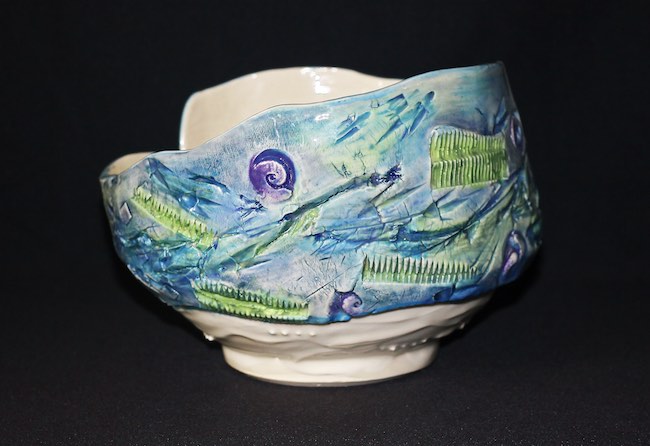Il percorso compiuto da alcune tecniche artistiche ma anche artigiane del passato è stato contraddistinto da periodi in cui erano esaltate e celebrate come sinonimo di raffinatezza e di benessere economico e sociale, altre in cui invece erano lasciate in secondo piano rispetto alla pittura e alla scultura; in particolar modo la ceramica, pur essendo una materia con cui si sono misurati i maestri dell’arte di ogni secolo, e pur essendo talmente plastica e neutra come superficie da poter essere plasmata e armonizzata con l’intento espressivo di ciascun arista, è costantemente stata vista come un complemento d’arredo, come un decoro ben diverso per importanza rispetto a un dipinto. Tuttavia vi sono creativi che invece tendono naturalmente verso questo tipo di materia riuscendo a dare un’impronta incisiva sul messaggio che desiderano lasciare all’osservatore; la protagonista di oggi appartiene a questo gruppo di artisti.
L’arte della decorazione della terracotta ha radici antichissime grazie alle quali si è potuto avere una traccia e una testimonianza della vita e delle abitudini delle grandi civiltà del passato come quella greca, la giapponese, la cinese, la mesopotamica che usavano descrivere scene di vita e accadimenti epici sulle pareti di vasi e urne; la minuzia con cui erano eseguiti i disegni stilizzati lasciava intuire la maestria e la rilevanza che le arti avevano anche in epoche lontane. Con il passare dei secoli le ceramiche divennero via via maggiore espressione dell’arte decorativa, affinando la ricerca sulla tecnica esecutiva che nel Settecento, con la creazione della porcellana, riuscì a riprodurre la durezza delle antiche ceramiche cinesi risalenti a diciassette secoli prima di Cristo; i disegni riprodotti erano affini agli stili artistici e pittorici, conquistando così un posto di primo piano nei salotti nobili e aristocratici dove erano immancabili questi oggetti di pregio. Nel Novecento però, a seguito della rivoluzione creativa ed espressiva che interessò l’intero mondo artistico, la ceramica si assecondò alle molteplici esigenze rappresentative dei vari movimenti che ne fecero ampio uso, come l’Art Nouveau, in cui vi fu una nuova celebrazione della coesione e sinergia tra arti e mestieri elevando così antiche tecniche artigiane al livello di arte primaria. Dunque la rivoluzione non poteva non coinvolgere anche la stessa ceramica che divenne protagonista di sculture, oltre che di vasi e anfore, eseguite dai maggiori esponenti dell’epoca e anche di quella appena successiva, come Leoncillo Leonardi, che ha attraversato diversi stili come l’Art Nouveau, il Cubismo per poi tendere verso l’Informale; Lucio Fontana che plasma la superficie dura della terracotta per assottigliarla e contraddistinguerla da fori e tagli secondo le linee guida dello Spazialismo, movimento da lui fondato e che lo ha reso celebre nel mondo; e ancora Pablo Picasso che vedeva nella modellazione dell’argilla un rapporto primordiale con la terra, quell’essere in grado di agire velocemente, mescolare i colori senza conoscere il risultato finale finché essa non si fosse asciugata costituendo una sfida ma anche un mezzo per permettere a un vasto pubblico, che non avrebbe potuto permettersi di acquistare un dipinto o una scultura, di avvicinarsi e conoscere l’arte moderna. Nell’era contemporanea la ceramica ha assunto una nuova veste che la vede come materiale scultoreo al pari del marmo, del bronzo e di altri più tradizionali, conquistando grazie alla sua maggiore plasmabilità e duttilità un nutrito numero di artisti ormai affermati nel panorama internazionale che hanno fatto della ceramica artistica la loro unica forma espressiva. L’artista canadese Lise B. L. Goulet, malgrado la formazione come incisore, non può fare a meno di avvicinarsi e di scegliere la ceramica come materiale più affine alle sue corde creative, forse perché anche lei, come Picasso, non riesce a rinunciare a quel contatto primordiale con la terra che attraverso le sue mani riesce a trasformarsi in messaggio, in racconto di ciò che dentro di sé prova; e il fatto che per decorare le sue sorprendenti anfore utilizzi l’Espressionismo Astratto la pone in maggiore contatto con un’interiorità che ha bisogno di raccontare senza rappresentare perché in fondo la definizione è lasciata alla materia in grado di assecondarsi a tutto il significante dell’artista che deve trasmettere al fruitore.
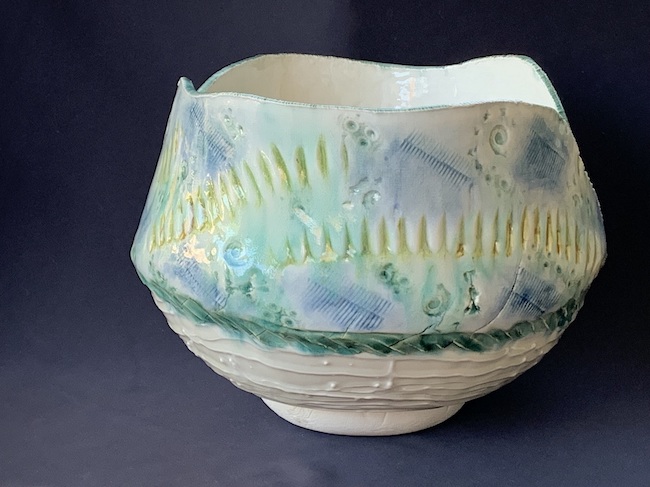
Le sue anfore, i suoi vasi sono infatti modellati in maniera insolita, divengono sculture metafisiche poiché rappresentano un senso differente rispetto a quello abitualmente osservato, le parti che dovrebbero essere chiuse si aprono per lasciar uscire un pulsare nascosto, una voce inascoltata perché ignorata dalla distrazione dell’individuo che difficilmente si pone in ascolto della natura e delle energie che la avvolgono.
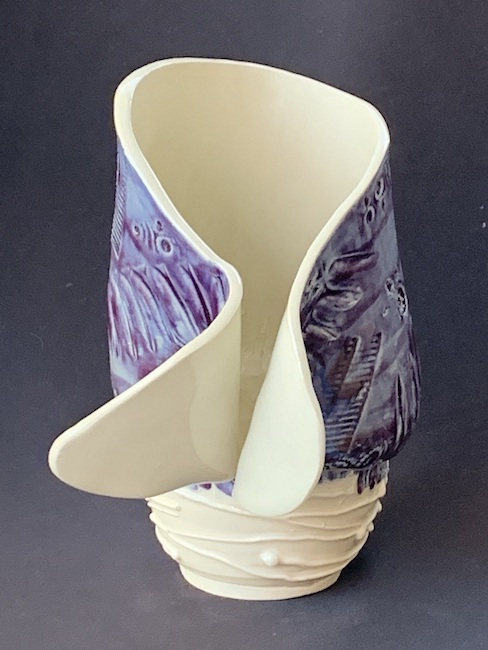
Il tema principale della produzione di Lise B. L. Goulet è proprio quello della natura, di un desiderio di sensibilizzazione nei confronti di qualcosa che accoglie quotidianamente l’essere umano che spesso dimentica il ruolo fondamentale che essa ricopre, quello di nutrire, di dissetare, di infondere vita grazie al suo ciclo che tutto domina ed equilibra. Non solo, è anche scrigno e testimonianza dello scorrere del tempo, dell’alternarsi dei secoli e di tutto ciò che li ha contraddistinti; è forse questo che l’artista desidera far uscire dai suoi vasi, quel patrimonio silenzioso ma inestimabile di emozioni, sensazioni, evoluzioni testimonianza delle modificazioni della società e dell’essere umano.
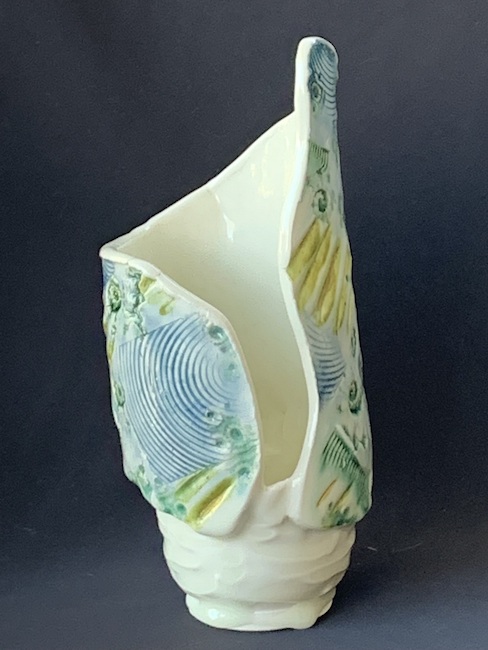
Tutta la natura, l’acqua, il mare, i fiori, il susseguirsi delle stagioni sono di ispirazione per le sue decorazioni espressioniste astratte che assumono al contempo un aspetto meditativo, morbido, a sottolineare l’accoglienza e la delicatezza di tutto ciò che avvolge l’uomo e ne lambisce l’esistenza, ma anche concreto in virtù delle linee, dei segni che la sua tecnica incisoria, con particolare predilezione per l’acquaforte, la induce a tracciare nei suoi vasi per enfatizzare la realtà e la bellezza dei fondali marini, dei fiori, come se Lise B. L. Goulet volesse trasmettere la loro forza e resilienza in un mondo che troppo frequentemente li aggredisce. Dunque i segni che divengono parte integrante delle opere in ceramica sembrano quasi una stilizzazione tribale, come se l’artista suggerisse di ritrovare la semplicità e la magia di un tempo in cui i fenomeni naturali, gli elementi e le stagioni stesse erano considerati un dono degli dei e come tali rispettati e venerati; non solo, i suoi vasi, aprendosi verso l’esterno sembrano suggerire di non voler più solo contenere silenziosamente, bensì chiedono anche di essere ascoltati e rispettati per la loro rilevanza, per il loro ruolo essenziale nel ciclo della vita.
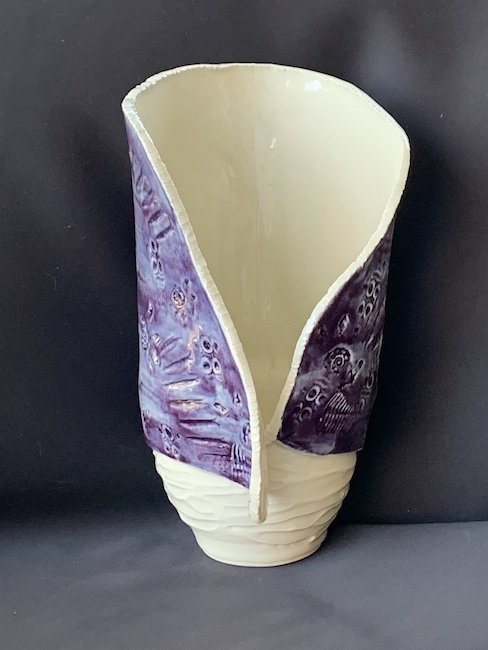
Divide le sue sculture in serie Lise B. L. Goulet, e si lascia guidare dal flusso di energia che percepisce nel momento in cui si mette in posizione di ascolto nei confronti del mondo circostante; in Série Grande des Mystère cerca di infondere nell’osservatore la stessa curiosità, il medesimo fascino che percepisce quando osserva la natura umana, quell’uomo che è stato capace di creare grandi cose e al tempo stesso di distruggere tutto, quell’alternanza tra bene e male, tra buono e cattivo che nel corso dei secoli ha generato periodi di grande pace e positività a cui poi sono subentrati guerre e devastazioni di interi ecosistemi, non considerando che a essere a rischio per questi comportamenti è egli stesso.
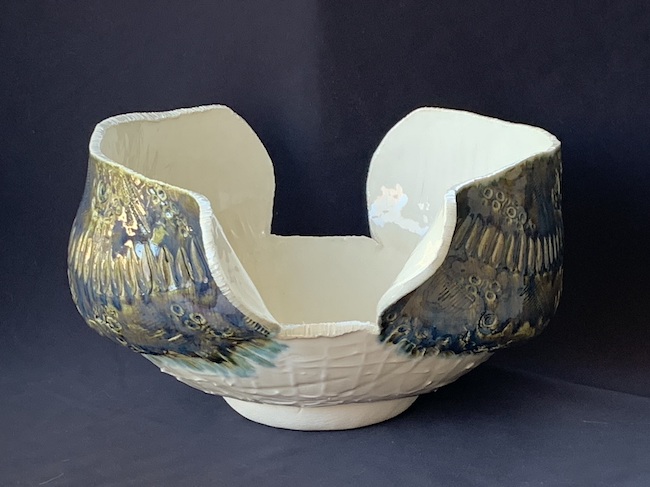
Nell’opera À l’ombre de ses mystères Lise B. L. Goulet sembra aprire completamente il vaso alla conoscenza, quasi come se suggerisse che senza mettersi a nudo non sarebbe possibile compiere quel percorso introspettivo in virtù del quale poter comprendere limiti ed errori.
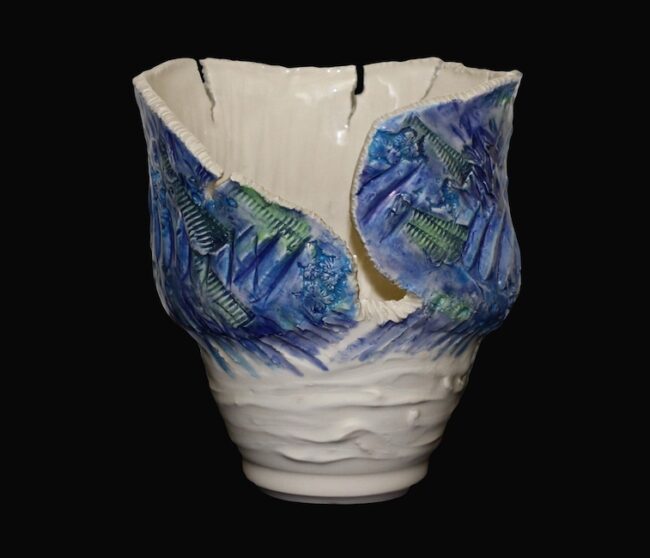
In Destin d’eaux vives della Série des Bassins versants (Serie Spartiacque) l’artista sottolinea l’importanza dello spartiacque, la linea che separa naturalmente due bacini idrografici, il quale in senso fisico viene messo in pericolo da un’economia aggressiva e votata al profitto con il rischio di compromettere l’equilibrio che in sua virtù è mantenuto, mentre in senso metaforico rappresenta una demarcazione tra un estremo e l’altro, tra il restare all’interno di ciò che è giusto o l’andare oltre provocando conseguenze a volte irreparabili.
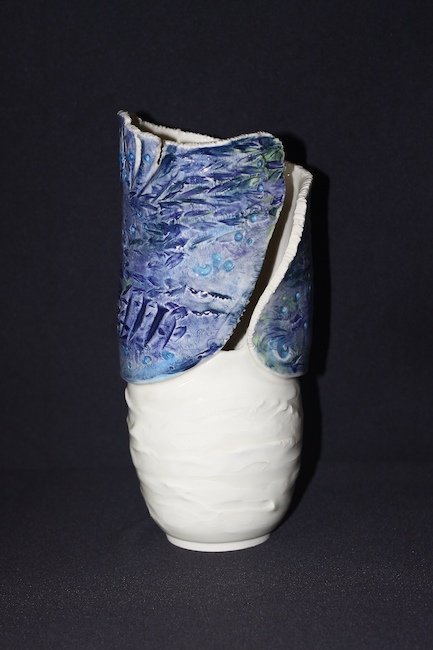
Dunque la natura in qualche modo diviene legame con un’interiorità contemporanea perduta dentro la superficialità, che ha dimenticato le radici e tutto ciò che ha costituito una base essenziale per l’umanità stessa. Lise B. L. Goulet, nipote del grande artista canadese Clément Bérini, ha studiato a fondo la tecnica Raku, ha all’attivo molte mostre personali e collettive e le sue opere sono state pubblicate in molte riviste d’arte, cataloghi e monografie.
LISE GOULET-CONTATTI
Email: marcelleclement1@gmail.com
Sito web: http://www.bravoart.org/cb-profile/380-goulet
Facebook: https://www.facebook.com/lisebl.goulet.5
Lise B. L. Goulet, abstract decorations on ceramic not to lose touch with naturalness
The path followed by certain artistic but also artisanal techniques of the past has been marked by periods in which they were exalted and celebrated as synonymous with refinement of economic and social well-being, and others in which they were left in second place to painting and sculpture; in particular, ceramics, despite being a material with which the masters of art of every century have measured themselves, and despite being so plastic and neutral as a surface that it can be moulded and harmonised with the expressive intent of each artist, has constantly been seen as a furnishing accessory, as a decoration quite different in importance from a painting. However, there are creatives who naturally tend towards this type of material, succeeding in making an incisive impression on the message they wish to leave to the observer; today’s protagonist belongs to this group of artists.
The art of terracotta decoration has very ancient roots, thanks to which we have traces and evidence of the life and customs of the great civilisations of the past, such as the Greeks, Japanese, Chinese and Mesopotamians, who used to depict scenes of life and epic events on the walls of vases and urns; the meticulousness with which the stylised designs were executed hinted at the mastery and importance that the arts had even in distant times. With the passing of the centuries, ceramics gradually became a greater expression of the decorative art, refining research on the executive technique that in the 18th century, with the creation of porcelain, succeeded in reproducing the hardness of ancient Chinese ceramics dating back to seventeen centuries before Christ; the designs reproduced were akin to artistic and pictorial styles, thus conquering a prominent place in the noble and aristocratic salons where these precious objects were a must. In the 20th century, however, as a result of the creative and expressive revolution that affected the entire artistic world, ceramics met the multiple representational needs of the various movements that made extensive use of them, such as Art Nouveau, in which there was a new celebration of the cohesion and synergy between arts and crafts, thus elevating ancient craft techniques to the level of primary art.
So the revolution could not fail to involve ceramics itself, which became the protagonist of sculptures, as well as vases and amphorae, made by the greatest exponents of the period and also of the one that just followed, such as Leoncillo Leonardi, who went through different styles such as Art Nouveau, Cubism and then tended towards Informalism; Lucio Fontana who moulded the hard surface of terracotta to thin it and distinguish it with holes and cuts according to the guidelines of Spatialism, a movement he founded and which made him famous throughout the world; and again Pablo Picasso who saw in modelling clay a primordial relationship with the earth, that being able to act quickly, mixing colours without knowing the final result until it had dried, constituting a challenge but also a means to allow a vast public, who could not afford to buy a painting or a sculpture, to approach and learn about modern art. In the contemporary era, ceramics has taken on a new guise as a sculptural material on a par with marble, bronze and other more traditional materials, conquering, thanks to its greater malleability and pliability, a large number of artists now established on the international scene who have made artistic ceramics their sole form of expression.
Canadian artist Lise B. L. Goulet, despite her training as an engraver, cannot help but approach and choose ceramics as the material most akin to her creative chords, perhaps because she too, like Picasso, cannot renounce that primordial contact with the earth that through her hands manages to transform itself into a message, into a tale of what she feels inside; and the fact that she uses Abstract Expressionism to decorate her astonishing amphorae puts her in greater contact with an interiority that needs to tell without representing because, in the end, the definition is left to the material that is able to go along with all the artist’s signifier that must be conveyed to the viewer. Her amphorae, her vases are in fact modelled in an unusual way, they become metaphysical sculptures because they represent a different meaning than the one usually observed, the parts that should be closed open up to let out a hidden pulsing, an unheard voice because ignored by the distraction of the individual who hardly listens to nature and the energies that envelop it. The main theme of the production of Lise B. L. Goulet is precisely that of nature, of a desire to raise awareness of something that daily welcomes the human being who often forgets the fundamental role it plays, that of nourishing, of quenching, of infusing life thanks to its cycle that dominates and balances everything. Not only that, it is also a treasure chest and testimony of the passage of time, of the alternation of the centuries and all that has marked them; it is perhaps this that the artist wishes to bring out of her vases, that silent but priceless heritage of emotions, sensations, evolutions that bear witness to the changes in society and the human being.
All of nature, water, the sea, flowers, the succession of the seasons are the inspiration for her abstract expressionist decorations, which at the same time take on a meditative, soft aspect, underlining the welcome and delicacy of everything that envelops man and touches his existence, but also concrete by virtue of the lines, the signs that her engraving technique, with a particular predilection for etching, induces her to trace in her vases to emphasise the reality and beauty of the seabed, of flowers, as if Lise B. L. Goulet wanted to convey their strength and resilience in a world that all too frequently assaults them. Thus, the signs that become an integral part of the ceramic works almost seem like tribal stylisation, as if the artist were suggesting to rediscover the simplicity and magic of a time when natural phenomena, the elements and the seasons themselves were considered a gift from the gods and as such respected and worshipped; not only that, her vases, opening outwards, seem to suggest that they no longer want to silently contain, but also ask to be listened to and respected for their relevance, for their essential role in the cycle of life. She divides her sculptures into series Lise B. L. Goulet, and lets herself be guided by the flow of energy that she perceives when she puts herself in a listening position to the world around her; in Série Grande des Mystère (Great mysteries series), she tries to instil in the observer the same curiosity, the same fascination that she perceives when she observes human nature, that man who has been able to create great things and at the same time destroy everything, that alternation between good and evil, between good and bad that over the centuries has generated periods of great peace and positivity to which wars and the devastation of entire ecosystems have then succeeded, not considering that he himself is at risk for these behaviours.
In À l’ombre de ses mystères (Under the shadow of his mysteries), Lisa B.L. Goulet seems to open up the vessel completely to knowledge, almost as if to suggest that without laying oneself bare, it would not be possible to make that introspective journey by virtue of which is possible to understand limits and errors. In Destin d’eaux vives (Fate of living waters) from the Série des Bassins versants (Watershed Series), the artist emphasises the importance of the watershed, the line that naturally separates two river basins, which in a physical sense is endangered by an aggressive, profit-driven economy with the risk of compromising the balance that is maintained by virtue of it, while in a metaphorical sense it represents a demarcation between one extreme and the other, between staying within what is right or going beyond it causing sometimes irreparable consequences. So nature somehow becomes a link with a contemporary interiority lost within superficiality, which has forgotten its roots and everything that constituted an essential basis for humanity itself. Lise B. L. Goulet, niece of the great Canadian artist Clément Bérini, has studied the Raku technique in depth, has many solo and group exhibitions to her credit and her works have been published in many art magazines, catalogues and monographs.


